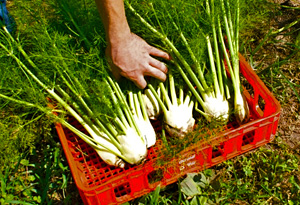Food Is Love

Photo: Rick Martin
This is it. Right now. Simran Sethi says this is the time to get to a farmer's market and savor the tastes of the summer. Don't squander it.
This is the season when fragrant peaches yield to the touch, carrots don't look anemic, and tomatoes taste like tomatoes. You know what I'm talking about. Tomatoes: sweet, tender, juicy; not the mealy, flesh-colored objects that masquerade as tomatoes in the dead of winter, shipped from miles and miles away. No, tomatoes that are only available when the season allows it—the ones that couldn't weather the 1,700-mile journey that the average food item on a North American plate travels from farm to fork.There is something sacred in the taste of an organic heirloom tomato. It is something a long-distance tomato—bred not for taste but endurance to be shipped without bruising—just can't possess. There is something precious about eating a fruit grown close to home, in season. It doesn't just taste better; it's also better for you. Plants lose nutritional value when they're pulled off the vine before they're ready. Travel-friendly but underripe, they mature on a ship or truck instead of under the sun.
What's more, there is something sacred about the hands that grew that tomato, the hands that feed us all. Yet the awareness of who grows our food and how they grow it is rarely front and center. Small and midsize farms have been on the decline for decades, unable to compete with the economies of scale that larger agribusinesses can offer. Transportation costs and additional farm expenses for petroleum-based fertilizers and pesticides have risen, while the amount of money going back to farmers has remained stagnant for more than a decade. According to the USDA, about 20 cents for every food dollar we spend goes back to the farmers.
Considering these numbers, it should come as no surprise that, in the past five years, roughly 80,000 midsize farming operations have disappeared.



